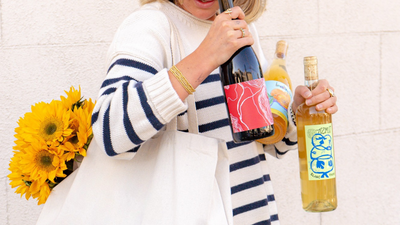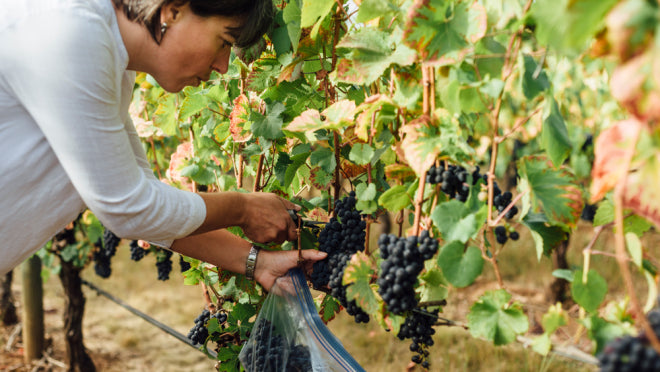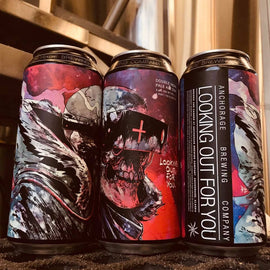2014, 2015, 2016 Lavinea Elton Vineyard Pinot Noir Eola-Amity Hills AVA, Willamette Valley, Oregon
Pinot Noir, the grape of red Burgundy, makes wines that are maddeningly elusive, changing by the minute in the glass. The first sip from a just-opened bottle can be gloriously sweet and fruity, but then the wine seems to close, putting up a tart boundary that fends off efforts to get at the flavors within. Let the wine sit 20 or 30 minutes, and it transforms again. The flavors deepen, with deep notes of chocolate and anise underlying the higher fruit and herbal flavors. This is the great allure of Pinot, and is what keeps the wine drinker on the constant search for that true “Burgundian” experience. Pinot works well with duck, game birds, mushroom dishes, pork and poultry. Given its generally softer tannic structure, it pairs well with fish and vegetable courses, and the wine can pull a whole table of different entrées together with a reliable degree of success.
Of all the varietals, Pinot Noir is perhaps one of the most sensitive to changes in growing conditions, (climate, soil, sun exposure, etc.) and the Willamette Valley in Oregon has proven to be one of the most ideal regions in the world for growing Pinot. Driving southwest from Portland and nestled between the Coastal and Cascade Ranges, the valley is punctuated by a succession of rolling hills, which were islands dotting an ancient lake 13,000-15,000 years ago. The best vineyards in Oregon sit on these hills, producing exceptional fruit on what were ancient beaches. The Willamette Valley became an official AVA in 1984, and 20 years later it was delineated into six sub-appellations: Dundee Hills, Eola-Amity Hills, McMinnville, Ribbon Ridge, Yamill-Carlton, and the recently approved Chehalem Mountains.
Oregon winemaker Isabelle Meunier might have learned her craft from some of the best winemakers in the world, but she believes the ground itself is responsible for the finest wines. In her words, “the celebrated wine regions of the world achieved their status by discovering and revealing, through exceptional wines, their greatest vineyards”. Isabelle studied viticulture at the University of Dijon and then worked under Pascal Marchand at Domaine de la Vougeraie in Burgundy. A native of Quebec, Isabelle was set on her path to Oregon by fellow French-Canadian, the aforementioned Marchand at Vougeraie. He recommended her as overseeing winemaker for a new Willamette Valley project his friend and French winemaking legend Dominique Lafon was consulting for called Evening Land. With her newest project Lavinea, Isabelle has mapped a course for revealing world-class sites through great single-vineyard Pinot Noirs.
Isabelle’s partner at Lavinea is Craig Ralston. Craig worked as managing director of Chateau Montelena in Napa Valley for many years and had worked with other renowned estates such as Castello di Volpaia and Ceretto from Italy, Domaine de la Romanee-Conti and Domaine Leflaive from Burgundy before being recruited to become President and CEO of Evening Land Vineyards in 2012. It was during this period, working with Isabelle, that they produced some of Oregon’s most highly acclaimed Pinot Noirs and Chardonnays. Greg is passionate about creating and sharing wines of unique distinction and advancing the Willamette Valley’s stature in the world of fine wine.
The three Pinot Noirs you are receiving are from the Elton Vineyard in the Eola-Amity Hills AVA. The climate in this region is greatly influenced by its position due east of the Van Duzer Corridor, which provides a break in the coast range that allows cool Pacific Ocean air to flow through. In 2007, Elton Vineyards was named one of Oregon’s top ten vineyards by Wine Press Northwest, and in 2006, Wine & Spirits listed it as one of the five key vineyards in the new Eola-Amity Hills American Viticultural Area. Owned by Dick and Betty O’Brien, the vineyard was planted on land inherited from Betty’s parents, Elton and Peggy Ingram – hence the name Elton Vineyards and the address on Ingram Lane. The first five acres of wine-grapes were planted in 1983 by the O'Briens. The vineyard now includes almost 94 acres planted on east-southeast slopes just west of Hopewell, in Yamhill County, in the Eola-Amity Hills AVA. The elevation rises from 350-750 feet, and the vineyard soils are volcanic Jory and basalt mother rock with iron-rich soils. The majority of the vineyard is planted in Pinot Noir; including Pommard, Wadensvil, 115, 777, and 114 clones. The vineyard also includes Dijon 76 and 96 Chardonnay.
Lavinea’s Pinot Noirs from the Elton Vineyard showcase terrific terroir, with complex earthiness (a forest-floor quality) under dark red fruit and spice. That fruit isn’t shy on the palate with juicy berry fruit perfectly balanced between lush and tart, wrapped in silky texture ending with a lovely finish. All three wines have a soft palate entry with a juicy and fruity core. The smooth and elegant texture travels the length of the palate and finishes with a wonderful brightness. Thy are the quintessential definition of a beautiful Pinot Noir, very complete and showing promises of getting better through time.
2014 Vintage & Winemaking Facts:
Picking date: September 15th, 2014
2014 Harvest Data: 24.3 brix, pH 3.39, TA 5.3 g/l
Cold Soaked: 6 days
Fermentation: Spontaneous native fermentation, gentle punch downs or pump over twice per day. Pressed: October 4th
Barreled: October 9th with 30% New French Oak
Malolactic fermentation: Indigenous and 100% complete by May 8th, 2015
Bottling Date: March 1st,2016
Cases produced: 243
Aging Potential: Over 5 years
“From 30-year-old vines, this is beautifully built and already showing the complexity that predicts a long life ahead. The old-vine grapes create a skeleton of mineral and acid upon which just-ripe fruit flavors of mulberry, plum and blueberry are placed. Drink now with pleasure or put a few bottles away to enjoy through 2027 or longer.” –Wine Enthusiast
2015 Vintage & Winemaking Facts:
Picking date: September 14th, 2015
Harvest Data: 24.3 brix, pH 3.35, TA 5.5 g/l
Cold Soaked: 6 days
Fermentation: Spontaneous native fermentation, gentle punch downs or pump over twice per day Pressed: September 29th
Barreled: October 2nh with 30% New French Oak
Malolactic fermentation: Indigenous and 100% complete by February 10th, 2016
Bottling Date: February 28th, 2017
Cases produced: 215
Aging Potential: Over 5 years
Winemaker Notes: Bright and classic ruby-red in color with a purple hue, the first fragrance conveys hints of rosemary and lavender and boasting mixed red and black fruits. It quickly opens in the glass to reveal bramble-berry and wed bedrock on a light spice frame. A soft palate entry with a juicy & fruity core, very smooth and elegant coating texture travels the length and finishes with a wonderful tightening. The quintessential definition of a beautiful Pinot Noir, very complete and showing promises of getting better through time
2016 Vintage & Winemaking Facts:
Picking date: August 30th & September 1st
2016 Harvest Data: 23.6 brix, pH 3.37, TA 5.7 g/l
Cold Soaked: 6 days
Fermentation: Spontaneous native fermentation, gentle punch downs or pump over twice per day. Pressed: September 17th
Barreled: September 23rd with 27% New French Oak
Malolactic fermentation: Indigenous and 100% complete by April 25th, 2017
Bottling Date: April 5th, 2018
Cases produced: 263
Aging Potential: Over 8 years
Winemaker Notes: Bright and deep purple in color with a bluish edge, the first nose opens with lovely aromas of sweet cherries in kirsch, fragrant rose and herbaceous rosemary, hints of lavender and boasting fresh cherries. Smooth and lush yet restrained and nervous, the lovely palate travels with a smooth beginning, vibrant core of fresh dark cherries and marionberries, wet bedrock and closing on an elegant finish sustained by silky tannins. The quintessential definition of a beautiful pinot noir, very complete and showing promises of getting better over time.
There is a much-repeated quote that “98 percent of Americans open a bottle of wine within 24 hours of purchase,” but a more recent survey shows that Americans do not really pop the cork or unscrew a screwcap as quickly as previously reported, with only 20 percent admitting that they drink the wine within 24 hours of purchase. The majority waits several days or weeks before consuming the wine, and a small percentage saves it for aging. Yet, throughout wine’s history scores of accolades have been written about aged wines and their ethereal qualities. Most wine drinkers, unless you are a collector, don’t have the chance to compare the same wine through multiple vintages (until now). We are fortunate and thrilled to have an opportunity to taste three Pinot Noirs from a single vineyard where the only real variable is the age of the wine. The winemaking for all three wines was almost identical, so it’s the vintage and the time the wine has spent in the bottle that should showcase each wine’s individuality. Our supply is extremely limited, (tiny quantities were produced of each) and our price is significantly lower than the winery's price, so this is a wonderful opportunity to buy a few extra bottles of each vintage to continue the exploration of what beautifully made Pinot can become if it’s given a chance to age.





